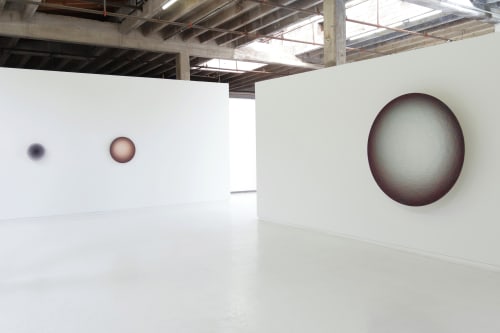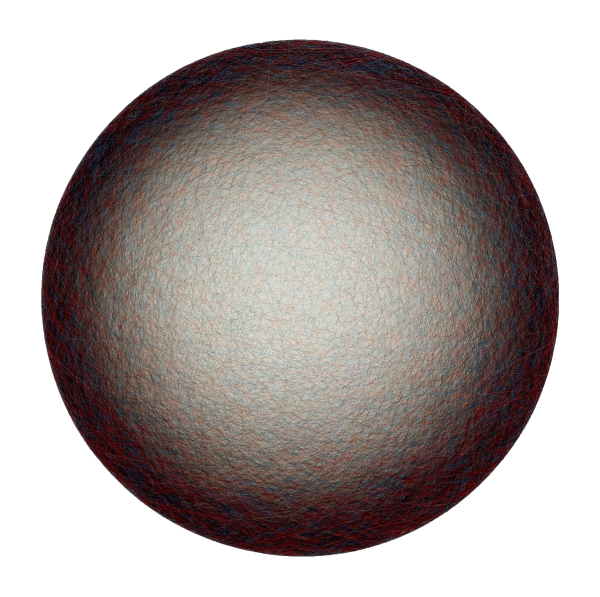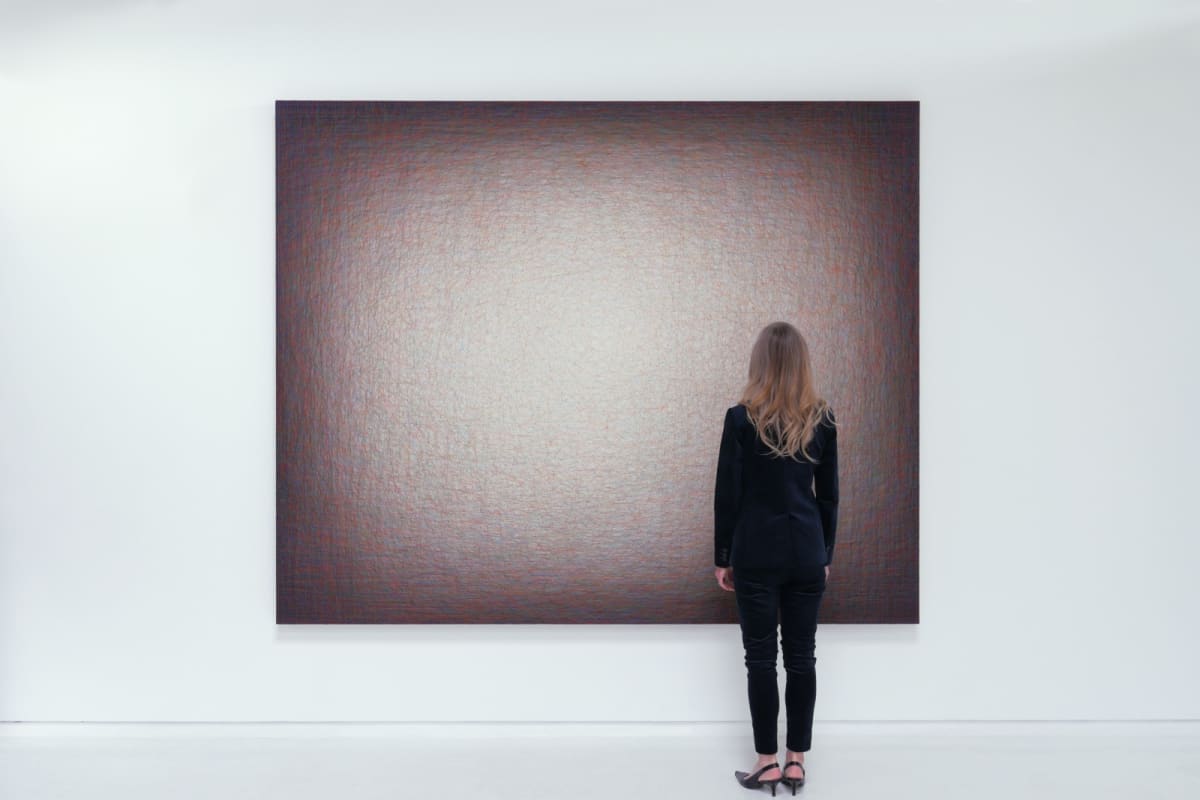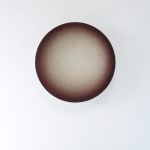Emil Lukas: All Connected, Like It or Not
Confounding and exquisitely strange, the objects that Emil Lukas develops out of his alchemical studio practice are meditations on the workings of the universe. Lukas interweaves the organic and mineral, micro and macro, ordinary and sublime, natural and technical, scientific and mystical in tinker-y processes that are ultimately transcendent.
Lukas’s seventh solo exhibition at Hosfelt Gallery is comprised of two types of work from his many-pronged approach. Baffling sumi ink paintings on glass that refer both aesthetically and by way of their titles to historical photographs are paired with Lukas’s signature “thread paintings” in two formats: gigantic, horizontal rectangles and variously scaled tondos. It’s a paradoxical juxtaposition, considering the historic presumption of photography as documentation and the fact that Lukas’s “thread paintings” are so profoundly bewildering.
The series of work he calls “lost photographs” has, in fact, no technical relationship to photographic processes, instead evolving from his decades-long experimentations utilizing the movements of other living creatures to draw lines. In this newest iteration, layers of pigments are dragged across glass, which Lukas then mounts backward and frames in blocky, wooden constructions. Though completely abstract, they indeed evoke damaged gelatin silver prints — faded, stained and with peeling emulsion — conjuring places or times half-remembered.
Lukas is perhaps best known for his “thread paintings,” which, true to his modus operandi, are not made with paint. Instead, he constructs shallow wooden trays, or parabolic bowls from plaster, across which he stretches tens of thousands of colored threads. The accumulation of delicate fiber lines creates complex color fields that shimmer and glow, changing radically with shifts in ambient light or the motion of the viewer.
The heroically-scaled, rectangular works glimmer moodily, calling to mind twilit windows. The round pieces, luminous and spatially ambivalent, seem alternately to project and recede, suggesting floating spheres or depressions in the architecture. They also call to mind planets and moons, or ocular devices that allude to the lens of a telescope, microscope, or camera.
So what do we make of Lukas’s not-photographs in the context of his non-paintings? From its invention, photography was presumed to reflect truth. Think “photographic evidence.” But in fact, almost from the beginning, tricksters (and artists) have used darkroom techniques to manipulate and distort fact. Lukas’s “lost photographs” put us in the mindset that we’re looking at a depiction of “reality.” But these pictures are not documentation and the memories they arouse in us are inventions. Similarly, his thread “paintings” are indeterminate, undermining our ability to trust our senses.
Humans have a deep need to figure things out. Some of us look for answers in religion, others in science. Many of the people who are reading this look for meaning in art. But the task of the artist is not to spoon feed us truths… it’s to ask us questions. What does ‘truth’ even mean? How do we know what we think we know? It’s the responsibility of a mindful viewer to come up with the answers. The magic of this exhibition is that from the humblest of materials — wood, plaster, glass, sumi ink and colored thread — Lukas conjures the most puzzling of objects: enigmatic artworks that defy definition and are open to as many interpretations as there are individual perspectives.
-
 Emil Lukas#1939, 2020thread, wood, plaster, paint, nails44 1/2 x 44 1/2 x 5 in
Emil Lukas#1939, 2020thread, wood, plaster, paint, nails44 1/2 x 44 1/2 x 5 in
113 x 113 x 12.7 cm -
 Emil Lukasfall way #1940, 2020thread, wood, plaster, paint, nails44 1/2 x 44 1/2 x 5 in
Emil Lukasfall way #1940, 2020thread, wood, plaster, paint, nails44 1/2 x 44 1/2 x 5 in
113 x 113 x 12.7 cm -
 Emil Lukaslost photograph #69 circa 1925 #1969, 2020hand-ground Sumi on glass over paper and graphite in painted wood frame15 x 12 x 2 in
Emil Lukaslost photograph #69 circa 1925 #1969, 2020hand-ground Sumi on glass over paper and graphite in painted wood frame15 x 12 x 2 in
38.1 x 30.5 x 5.1 cm -

-

-
 Emil Lukasradiant hum #2021, 2020thread, wood, paint, nails78 x 96 in
Emil Lukasradiant hum #2021, 2020thread, wood, paint, nails78 x 96 in
198.1 x 243.8 cm -
 Emil Lukaslost photograph #80 circa 1860 #1980, 2020hand-ground Sumi on glass over paper and graphite in painted wood frame12 x 15 x 2 in
Emil Lukaslost photograph #80 circa 1860 #1980, 2020hand-ground Sumi on glass over paper and graphite in painted wood frame12 x 15 x 2 in
30.5 x 38.1 x 5.1 cm -
 Emil Lukaslost photograph #83 circa 1915 #1983, 2020hand-ground Sumi on glass over paper and graphite in painted wood frame12 x 15 x 2 in
Emil Lukaslost photograph #83 circa 1915 #1983, 2020hand-ground Sumi on glass over paper and graphite in painted wood frame12 x 15 x 2 in
30.5 x 38.1 x 5.1 cm -
 Emil Lukaslost photograph #70 circa 1860 #1970, 2020hand-ground Sumi on glass over paper and graphite in painted wood frame15 x 12 x 2 in
Emil Lukaslost photograph #70 circa 1860 #1970, 2020hand-ground Sumi on glass over paper and graphite in painted wood frame15 x 12 x 2 in
38.1 x 30.5 x 5.1 cm -
 Emil Lukaslost photograph #72 9.2020 #1972, 2020hand-ground Sumi on glass over paper and graphite in painted wood frame15 x 12 x 2 in
Emil Lukaslost photograph #72 9.2020 #1972, 2020hand-ground Sumi on glass over paper and graphite in painted wood frame15 x 12 x 2 in
38.1 x 30.5 x 5.1 cm -
 Emil Lukaslost photograph #84 circa 1860 #1984, 2020hand-ground Sumi on glass over paper and graphite in painted wood frame12 x 15 x 2 in
Emil Lukaslost photograph #84 circa 1860 #1984, 2020hand-ground Sumi on glass over paper and graphite in painted wood frame12 x 15 x 2 in
30.5 x 38.1 x 5.1 cm -
 Emil Lukaslost photograph #85 circa 1915 #1985, 2020hand-ground Sumi on glass over paper and graphite in painted wood frame12 x 15 x 2 in
Emil Lukaslost photograph #85 circa 1915 #1985, 2020hand-ground Sumi on glass over paper and graphite in painted wood frame12 x 15 x 2 in
30.5 x 38.1 x 5.1 cm -

-


















